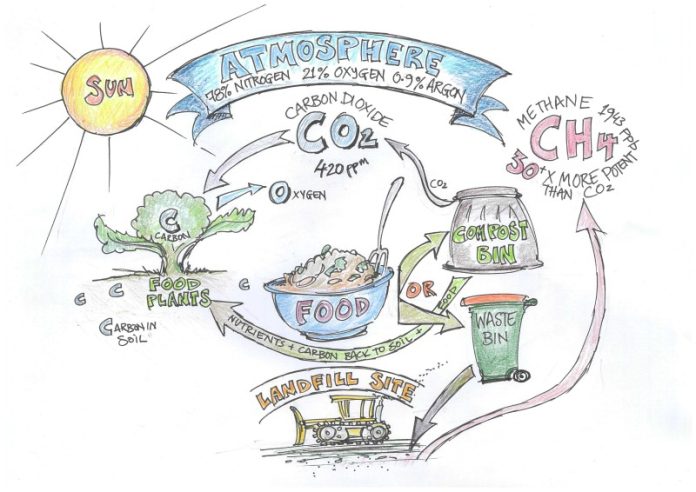
I’m sure we have heard that putting food scraps in our general waste bin, then burying them in a landfill site produces greenhouse emissions and that home composting is a “climate action we can take now”.
But isn’t it just the same organic material put in a different place? How can this make such a difference? Let’s take a little dive into greenhouse emissions.
In a landfill site, the organic material will be buried and compacted, with almost no oxygen. The only kind of bacteria that can break down our food scraps in such a low-oxygen environment are the ‘anaerobes’, bacteria that thrive in heavy, wet or buried locations.
Anaerobic bacteria breathe out methane (CH4), which is more potent at trapping the sun’s energy in our atmosphere than carbon dioxide is, perhaps 30 or more times as potent!
Methane doesn’t last in the atmosphere as long as carbon dioxide, but its intense impact as a greenhouse trapping gas happens in the first decade or so, meaning it can have a significant climate impact right now.
If, on the other hand, we put the same organic material into a well-blended and aerated compost pile (following the advice of the Compost Conversation, of course), we will be favouring the ‘aerobes’, bacteria that thrive in oxygen-rich environments.
Aerobic bacteria will break down the organic material in our compost, breathing out carbon dioxide (CO2), much like we do.
Now, carbon dioxide may not be as potent a greenhouse gas as methane, but it is the gas we hear about most when it comes to climate change, so why is composting any different to releasing carbon dioxide from burning coil, oil or gas?
When plants (like the plants that become the food we eat) grow, they use the sun’s energy, through photosynthesis, to build their bodies from the carbon dioxide in the atmosphere.
The same carbon in those plants’ bodies is the carbon aerobic bacteria feed on in our compost, then release as carbon dioxide. This is the natural background carbon cycle.
When we burn coal, oil or gas, on the other hand, we release the carbon that has been locked out of this natural carbon cycle, in fossil reserves, for millions of years.
So, when we compost our food scraps we are not adding to the carbon dioxide that is driving climate change, just participating in a natural cycle. And, when we compost well, quite a bit of the carbon in our food scraps can end up as more stable carbon in our soil, keeping carbon out of the atmosphere and improving the quality of our soil at the same time.
Composting done badly (think a heavy, stinky compost pile) will give off methane – not as much as the same material buried in a land-fill, but still a concern. Yet another reason to make sure our compost is aerated and sweet.
– Joel Meadows works with *Yes In My Back Yard, (YIMBY), a community-scale composting initiative in Castlemaine and surrounds. Send questions or comments to hello@yimbycompost.com, or to book in for a compost workshop.







